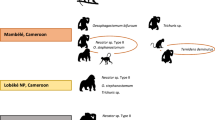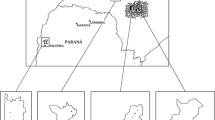Abstract
Purpose
Soil-transmitted nematodes (STNs) are widespread in tropical and subtropical regions, particularly where the communities are socio-economically challenged. We investigated the effect of soil temperature on the prevalence and intensity of STN infection in free-roaming dogs.
Methods
Fresh faecal samples collected from free-roaming dogs in Digana and Pussellawa town areas in the Kandy District, Sri Lanka, were microscopically analysed for canine STNs. Soil temperature was measured at each sampling site. Highly prevalent canine hookworm Ancylostoma, was further studied using PCR and sequencing, followed by phylogenetic analysis.
Results
The soil temperature ranged between 28 and 31 °C (mean = 29.79 °C) and 18–21 °C (mean = 19.52 °C) in Digana and Pussellawa, respectively, showing a significant difference in the two sites (Students t-test t = 1.68, p < 0.0001). Of the total 44 dogs sampled, 41 (93.2%) were positive for STNs. During microscopic analysis, five nematodes: Ancylostoma spp., Capillaria sp., Strongyloides sp., Toxocara canis, and Trichuris sp., were identified. Ancylostoma species (93.2%) were the most prevalent, followed by Strongyloides sp. (22.7%) and Toxocara canis (15.9%). Infection prevalence of Strongyloides sp. was higher in Digana (40.9%) compared to that in Pussellawa (4.5%; Chi-square test, χ2 = 8.28, p = 0.004) and also the infection intensity from Digana (EPG = 8.02 ± 20.2) compared to that from Pussellawa (0.45 ± 2.1; Mann Whitney U test, p = 0.006). Amplicons (ITS1-5.8S-ITS2) of the expected size for A. caninum, and A. tubaeforme were produced. An A. caninum sequence reported here (OQ101719) illustrated the highest similarity of 99.2% to one of the local sequences (MZ707153) upon pairwise comparison.
Conclusion
Digana, with a higher soil temperature than Pussellawa, had a significantly higher prevalence and infection intensity, particularly Strongyloides sp. This study also signifies the first molecular identification of hookworm species A. tubaeforme in Sri Lanka.




Similar content being viewed by others
Data Availability
The datasets generated during and/or analysed during the current study are available on the Open Science Framework site (link: https://osf.io/tpd9g).
References
CDC (2022) Soil-Transmitted Helminths. CDC. https://www.cdc.gov/parasites/sth/index.html. Accessed 21 Aug 2023
WHO (2023) Soil-Transmitted Helminth Infections. WHO. https://www.who.int/news-room/fact-sheets/detail/soil-transmitted-helminth-infections. Accessed 29 Aug 2023
Knopp S, Steinmann P, Keiser J, Utzinger J (2012) Nematode infections. Infect Dis Clin 26:341–358. https://doi.org/10.1016/j.idc.2012.02.006
Pullan RL, Brooker SJ (2012) The global limits and population at risk of soil-transmitted helminth infections in 2010. Parasit Vectors 5:1–14. https://doi.org/10.1186/1756-3305-5-81
Brooker S, Bethony J, Hotez PJ (2004) Human hookworm infection in the 21st century. Adv Parasitol 58:197–288. https://doi.org/10.1016/S0065-308X(04)58004-1
Jones KR (2021) Trichuris spp. in animals, with specific reference to neo-tropical rodents. Vet Sci 8:2–15. https://doi.org/10.3390/vetsci8020015
Siyadatpanah A, Pagheh AS, Daryani A, Sarvi S, Hosseini SA, Norouzi R et al (2020) Parasitic helminth infections of dogs, wolves, foxes, and golden jackals in Mazandaran Province, North of Iran. Vet World 13:2643–2648. https://doi.org/10.14202/vetworld.2020.2643-2648
Mekonnen Z, Getachew M, Bogers J, Vercruysse J, Levecke B (2019) Assessment of seasonality in soil-transmitted helminth infections across 14 schools in Jimma Town, Ethiopia. Pan Afr Med J 32:6. https://doi.org/10.11604/pamj.2019.32.6.16085
Jenkins EJ, Schurer JM, Gesy KM (2011) Old problems on a new playing field: Helminth zoonoses transmitted among dogs, wildlife, and people in a changing northern climate. Vet Parasitol 182:54–69. https://doi.org/10.1016/j.vetpar.2011.07.015
Mas-Coma S, Valero MA, Bargues MD (2008) Effects of climate change on animal and zoonotic helminthiases. OIE Rev Sci Tech 27:443–57. https://doi.org/10.20506/RST.27.2.1822
Paquet-Durand I, Hernández J, Dolz G, Zuñiga JJR, Schnieder T, Epe C (2007) Prevalence of Toxocara spp., Toxascaris leonina and ancylostomidae in public parks and beaches in different climate zones of Costa Rica. Acta Trop 104:30–37. https://doi.org/10.1016/j.actatropica.2007.06.011
Panigrahi PN, Gupta AR, Behera SK, Panda BSK, Patra RC, Mohanty BN et al (2014) Evaluation of gastrointestinal helminths in canine population of Bhubaneswar, Odisha, India: a public health appraisal. Vet World 7:295–8. https://doi.org/10.14202/vetworld.2014.295-298
Drake J, Carey T (2019) Seasonality and changing prevalence of common canine gastrointestinal nematodes in the USA. Parasit Vectors 12:1–7. https://doi.org/10.1186/s13071-019-3701-7
Amarasekera M, Gunawardena NK, de Silva NR, Douglass JA, O’Hehir RE, Weerasinghe A (2012) Impact of helminth infection on childhood allergic diseases in an area in transition from high to low infection burden. Asia Pac Allergy 2:122–128. https://doi.org/10.5415/apallergy.2012.2.2.122
Jenkins TP, Rathnayaka Y, Perera PK, Peachey LE, Nolan MJ, Krause L et al (2017) Infections by human gastrointestinal helminths are associated with changes in faecal microbiota diversity and composition. PLoS One 12:e0184719. https://doi.org/10.1371/journal.pone.0184719
Perera PK, Rajapakse RPVJ, Rajakaruna RS (2013) Gastrointestinal parasites of dogs in Hantana area in the Kandy District. J Natl Sci Found Sri Lanka 41:81–91. https://doi.org/10.4038/jnsfsr.v41i2.5703
De Silva TK, Rajakaruna RS, Mohotti KM, Rajapakse RPVJ, Perera PK (2022) First molecular identification of Ancylostoma species in dogs in a rural tea estate community in Sri Lanka and the detection of other zoonotic gastro-intestinal parasites. Acta Parasitol 67:1086–1096. https://doi.org/10.1007/s11686-022-00531-7
Bandaranayaka KO, Rajapakse RPVJ, Rajakaruna RS (2019) Potentially zoonotic gastrointestinal parasites of dogs in Lunugala Tea estate community in Central Sri Lanka. Ceylon J Sci 48:43–50. https://doi.org/10.4038/cjs.v48i1.7587
Gunawardena K, Kumarendran B, Ebenezer R, Gunasingha MS, Pathmeswaran A, de Silva N (2011) Soil-transmitted helminth infections among plantation sector schoolchildren in Sri Lanka: prevalence after ten years of preventive chemotherapy. PLoS Negl Trop Dis 5:e1341. https://doi.org/10.1371/journal.pntd.0001341
Taylor MA, Coop RL, Wall RL (2016) Veterinary Parasitology. Blackwell, London
Fu Y, Huang Y, Abuzeid AMI, Hang J, Yan X, Wang M et al (2019) Prevalence and potential zoonotic risk of hookworms from stray dogs and cats in Guangdong. China Vet Parasitol Reg Stud Reports 17:100316. https://doi.org/10.1016/j.vprsr.2019.100316
Larkin MA, Blackshields G, Brown NP, Chenna R, Mcgettigan PA, McWilliam H et al (2007) Clustal W and Clustal X version 2.0. Bioinformatics 23:2947–2948. https://doi.org/10.1093/bioinformatics/btm404
Swofford DL (1993) PAUP: phylogenetic analysis using parsimony Version 3.1. CIPRES cyberinfrastructure for phylogenetic research. https://www.phylo.org/tools/obsolete/Paup_Doc_31.pdf. Accessed 7 Aug 2023
Tamura K, Stecher G, Peterson D, Filipski A, Kumar S (2013) MEGA6: molecular evolutionary genetics analysis version 6.0. Mol Biol Evol 30:2725–2729. https://doi.org/10.1093/molbev/mst197
Sepalage CS, Perera PK, Rajakaruna RS (2020) Helminthiasis in dogs of University of Peradeniya premises: a potential public health problem. Ceylon J Sci 49:29–36. https://doi.org/10.4038/cjs.v49i1.7703
Gilles HM (1985) Selective primary health care: strategies for control of disease in the developing world. XVII. Hookworm infection and anemia. Rev Infect Dis 7:111–118. https://doi.org/10.1093/clinids/7.1.111
Okulewicz A (2017) The impact of global climate change on the spread of parasitic nematodes. Ann Parasitol 63:15–20. https://doi.org/10.17420/ap6301.79
Blum AJ, Hotez PJ (2018) Global “worming”: climate change and its projected general impact on human helminth infections. PLoS Negl Trop Dis 12:e0006370. https://doi.org/10.1371/journal.pntd.0006370
Page W, Judd JA, Bradbury RS (2018) The unique life cycle of Strongyloides stercoralis and implications for public health action. Trop Med Infect Dis 3:53. https://doi.org/10.3390/tropicalmed3020053
Preisser W (2019) Latitudinal gradients of parasite richness: a review and new insights from helminths of cricetid rodents. Ecography 42:1315–1330. https://doi.org/10.1111/ecog.04254
Dobzhansky T (1950) Evolution in the tropics. Am Sci 38:209–221
Gaston KJ (2000) Global patterns in biodiversity. Nature 405:220–227. https://doi.org/10.1038/35012228
Willig MR, Kaufman DM, Stevens RD (2003) Latitudinal gradients of biodiversity: pattern, process, scale, and synthesis. Annu Rev Ecol Evol Syst 34:273–309. https://doi.org/10.1146/annurev.ecolsys.34.012103.144032
Amarasena PGDS, Mohotti KM, De Costa DM (2016) Effects of changing rainfall and soil temperature on population density of Pratylenchus loosi in tea lands at different elevations. Trop Agric Res 27:265–276. https://doi.org/10.4038/tar.v27i3.8205
Traversa D, Frangipane Di Regalbono A, Di Cesare A, La Torre F, Drake J, Pietrobelli M (2014) Environmental contamination by canine geohelminths. Parasit Vectors 7:67. https://doi.org/10.1186/1756-3305-7-67
Traversa D (2012) Pet roundworms and hookworms: a continuing need for global worming. Parasit Vectors 5:1–19. https://doi.org/10.1186/1756-3305-5-91
Dissanaike AS, Ihalamulla RL, De SD, Pathirana S, Weerakoon U, Amaratunga MS et al (2000) On a dead female hookworm, probably Ancylostoma tubaeforme, from the vitreous of a patient in Sri Lanka. Ceylon J Med Sci 43:25–30. https://doi.org/10.4038/cjms.v43i2.4871
Mahdy MAK, Lim YAL, Ngui R, Fatimah MS, Choy SH, Yap NJ et al (2012) Prevalence and zoonotic potential of canine hookworms in Malaysia. Parasit Vectors 5:1–7. https://doi.org/10.1186/1756-3305-5-88
Inpankaew T, Schär F, Dalsgaard A, Khieu V, Chimnoi W, Chhoun C et al (2014) High prevalence of Ancylostoma ceylanicum hookworm infections in humans, Cambodia, 2012. Emerg Infect Dis 20:976–982. https://doi.org/10.3201/eid2006.131770
Traub RJ (2013) Ancylostoma ceylanicum, a re-emerging but neglected parasitic zoonosis. Int J Parasitol 43:1009–1015. https://doi.org/10.1016/j.ijpara.2013.07.006
Shi XL, Fu YQ, Abdullahi AY, Wang MW, Yang F, Yu XG et al (2018) The mitochondrial genome of Ancylostoma tubaeforme from cats in China. J Helminthol 92:22–33. https://doi.org/10.1017/S0022149X17000116
Lucio-Forster A, Liotta JL, Yaros JP, Briggs KR, Mohammed HO, Bowman DD (2012) Morphological differentiation of eggs of Ancylostoma caninum, Ancylostoma tubaeforme, and Ancylostoma braziliense from dogs and cats in the United States. J Parasitol 98:1041–1044. https://doi.org/10.1645/GE-2928.1
Acknowledgements
We thank the technical staff of the Department of Zoology and the Department of Veterinary Pathobiology of University of Peradeniya for providing immense support in laboratory work. This work was supported by the University of Peradeniya Research Grants (Grant No: URG/2022/64/S).
Funding
This work was funded by the University of Peradeniya Research Grants (Grant no: URG/2022/64/S) Piyumali K. Perera.
Author information
Authors and Affiliations
Contributions
All authors contributed to the study conception and design. Material preparation, data collection and analysis were performed by [Sakunika Amarasingha] and [Piyumali K. Perera]. The first draft of the manuscript was written by [Sakunika Amarasingha] and all authors commented on previous versions of the manuscript. All authors read and approved the final manuscript.
Corresponding author
Ethics declarations
Conflict of interest
All authors declare no conflict of interest.
Ethical Approval
Ethical clearance for the study was obtained from the Ethical Clearance Committee of Postgraduate Institute of Science, University of Peradeniya, Sri Lanka (Reference no: CEC_PGIS_2022_04).
Additional information
Publisher's Note
Springer Nature remains neutral with regard to jurisdictional claims in published maps and institutional affiliations.
Rights and permissions
Springer Nature or its licensor (e.g. a society or other partner) holds exclusive rights to this article under a publishing agreement with the author(s) or other rightsholder(s); author self-archiving of the accepted manuscript version of this article is solely governed by the terms of such publishing agreement and applicable law.
About this article
Cite this article
Amarasingha, S., Anupama, N.M.T., Rajakaruna, R.S. et al. Effect of Soil Temperature on Canine Soil-Transmitted Nematodes in Kandy District with the First Record of Hookworm, Ancylostoma tubaeforme from Sri Lanka. Acta Parasit. (2024). https://doi.org/10.1007/s11686-024-00829-8
Received:
Accepted:
Published:
DOI: https://doi.org/10.1007/s11686-024-00829-8




